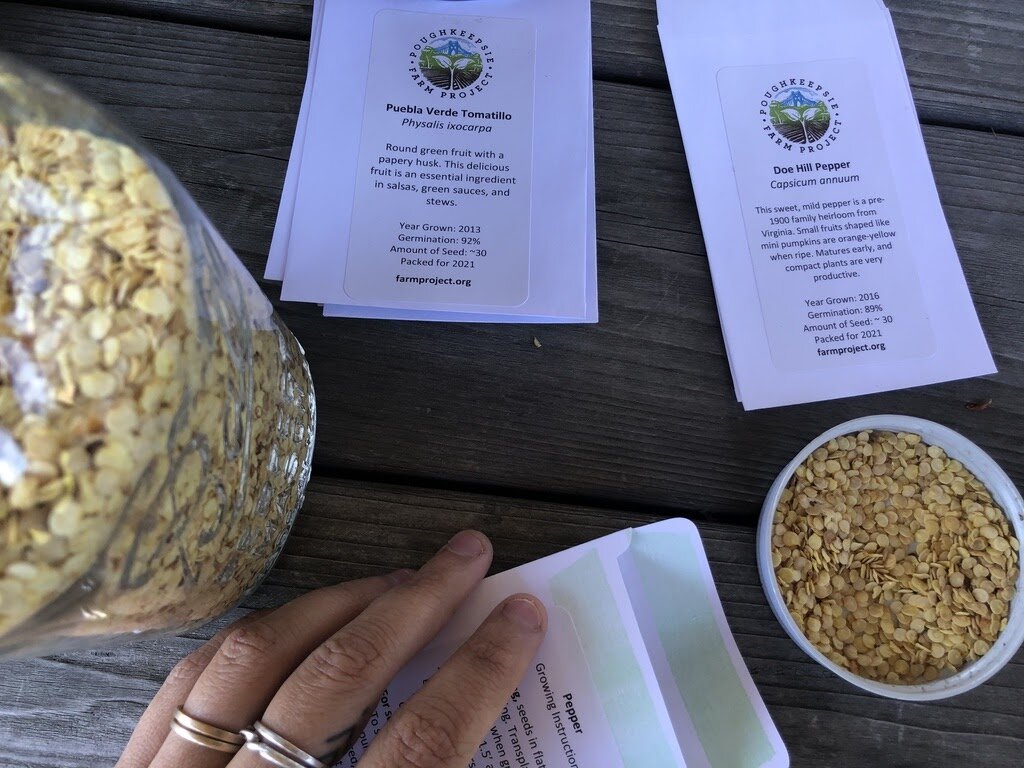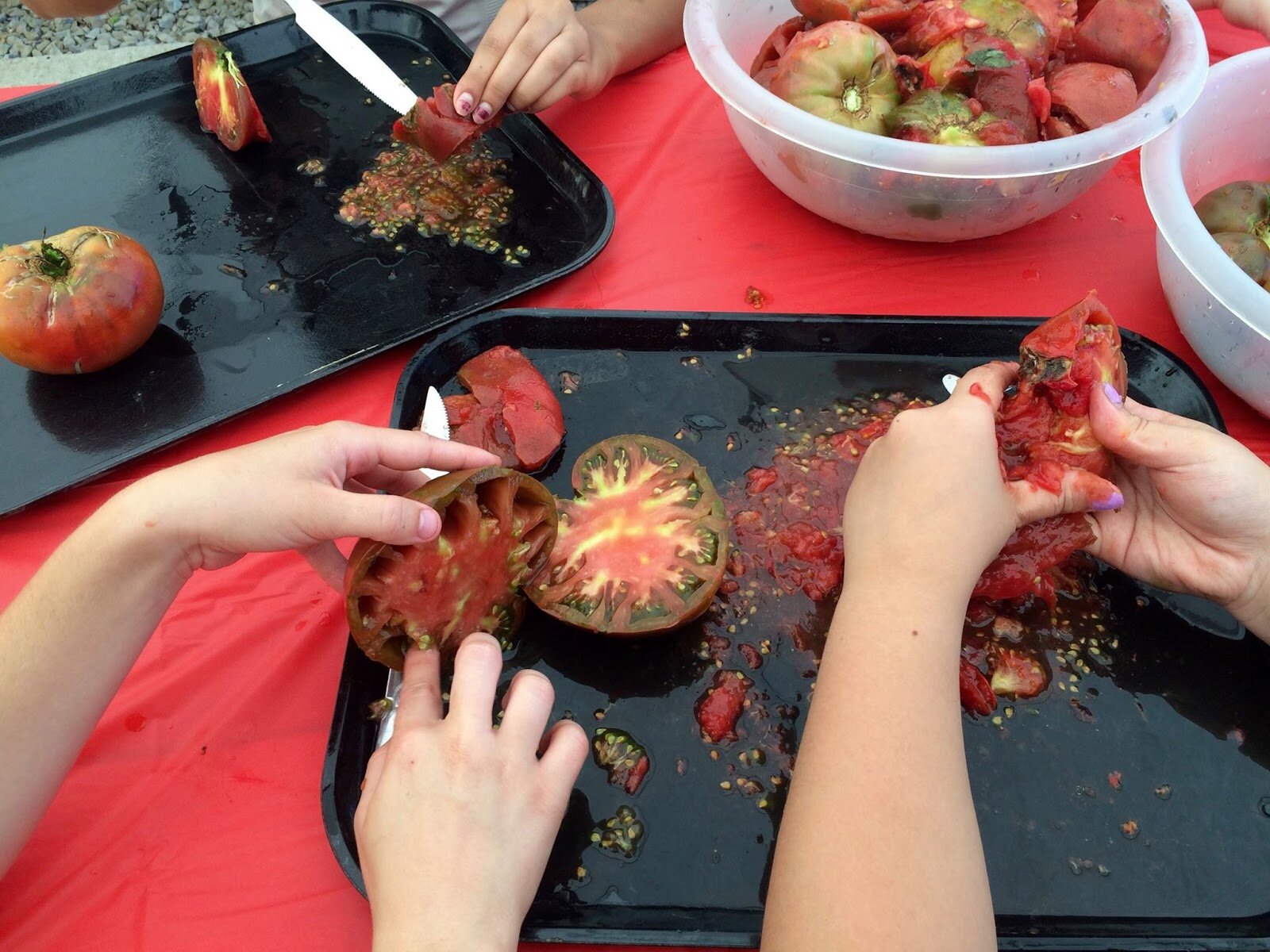by Aviva Magder-Pascaris, Education Intern Spring 2021
We too often think of our favorite animal when we think of extinction. I want you to picture that animal, and in its place imagine the seed for your favorite crop. Small yet mighty, seeds are indeed living things. They might spend a great deal of their lifetime in a small, dry, and hard shelled form, but once awoken, they provide incredible things for the world around them.
Seeds are the beginning and end of a plant's life cycle. They are the sustenance that nurtures the first leaf in a plant's life. They are food for all living things, human and nonhuman, and are even resilient in times of environmental disturbance. Despite this, many crop varieties are on the verge of extinction.
During my last week with the Poughkeepsie Farm project I got to package seeds for distribution. Pictured here are the Doe Hill pepper seed variety grown in 2016
When I started at Poughkeepsie Farm Project as an Education Intern, I did not expect to enter into an intense obsession with seeds. Seed varieties, seed saving techniques, seed histories, and seed sovereignty. To think that I was planting seeds not understanding their complexity seems impossible knowing what I know now.
Threats to Seed Diversity
So why are many varieties on the verge of extinction? As I began my research into the world of seeds, there was a narrative that stood out to me the most.
The United States has so vastly changed the agricultural landscape in the last 100 years. Small family farms have been wiped out by big destructive industry, land has been bought and sold by corporations that profit off of water, air, and the labor or people, and seed varieties have been bought up by agrochemical corporations; there are three private companies who own nearly 53% of the seed market.
Communities no longer control seeds, land, and water. Saving and protecting seeds isn’t just about making sure there is food on your plate, although this is an invaluable benefit. It is about resistance, and most importantly, the resilience and diversity of a food system for all peoples.
As we have seen in this last year, a resilient and just food system is necessary now more than ever before. And seeds, being the first link in the food system, are a great place to start.
Seed Saving: You, Me & PFP
Seed saving is not just for farmers, but for families, communities and individuals too. Here are some things I’ve learned about seed saving that I would like to share with you all. Actions I hope to carry into my work as an environmental educator, and that Poughkeepsie Farm Project and its community are taking part in.
Save, Plant, and Protect Diversity
Seed savers work to protect traditional, heirloom, and culturally significant crop varieties. Crop varieties refer to the specific types of a given crop such as the Midnight Black Turtle and the Tiger Eye beans or Amish Paste and Paul Robeson tomatoes. Maintaining a wide range of varieties of each crop means preserving a diversity of colors, flavors, textures, patterns, shapes, and sizes within our food system. Working together to protect diversity of food is foundational for community food sovereignty.
Here at Poughkeepsie Farm Project, the Seeds of the Food System program works to grow and save many varieties of seeds. Examples include the Paul Robeson Tomato, an heirloom variety named after a famous African-American opera singer and civil rights activist, northern-adapted Pigeon Peas, or “Gandules" in Spanish and "Gungo peas" in Jamaica, and the Aji Dulce Pepper a mild variety from the Carribean.
A variety of seeds saved here at the Poughkeepsie Farm Project
Preserve Cultural Heritage
Many organizations and communities save seed as a way to protect their cultural heritage, preserve the ancient practices of seed keepers, and develop multi-generational resistance to the current food economy that marginalizes BIPOC (Black, Indigenous, People Of Color) communities.
Poughkeepsie Farm Project works to support educational development and food distribution for the Poughkeepsie community through locally selling and donating seeds to individuals, families, nonprofits and schools. They also work to support the growth of seeds in libraries, such as the Newburgh Seed Library through donating saved seed.
Dragon Tongue & Tiger Eye bean varieties saved here at the Poughkeepsie Farm Project
Teach, and Learn!
It is so important to share what you know with your family and friends and keep learnings. Try saving seeds from vegetables and fruits you buy at the grocery store, or those you like to grow in your home or garden. Engage in learning about the seeds from your region, and the indigenous communities of the land. Beyond that, work to support BIPOC seed keepers, farmers, and food networks - resources linked below!
Poughkeepsie Farm Project’s education staff work with youth interns to grow plants for seed, and teach stewardship on the land. They offer free community workshops on how to engage with seed saving work, and as an organization they aspire to share and collaborate over botanical and agricultural knowledge with all residents of Poughkeepsie.
PFP interns saving tomato seeds
Resources for Continued Learning
Some of the seeds I plant and save in my parents home garden. Hudson Valley Seed Co’s organic, open-pollinated, heirloom variety seeds!
To learn more check out the resources I helped to develop below, which provide more information on starting seeds and saving seeds.
Seed Starting 101
Seed Saving Resource Packet
Check out another blog I wrote titled Seeding a Revolution: Sovereignty and Connection in the Food System
Look out for future programming on seed saving at the farm project by visiting their Seeds of the Food System page! To connect with the PFP seed project, contact seeds@farmproject.org.
Books
Ashworth, Suzanne, Seed to Seed: Seed Saving and Growing Techniques for Vegetable Gardeners
Rogers, Marc, Saving Seeds: The Gardener’s Guide to Growing and Storing Vegetable and Flower Seeds
Deppe, Carol, Breed Your Own Vegetable Varieties
Connolly, Brian, The Wisdom of Plant Heritage: Organic Seed Production and Saving
White, Rowen: Breeding Organic Vegetables: A Step-by-Step Guide for Growers
Somos Semilla and Sustainable Harvest International, Semillas Para Todos - Spanish Seed Saving Manual
Online
Seed Savers Exchange Learn & How-to Guides
Reclaim Seed NYC Resources in Spanish and English
Ira Wallace on Seed Saving and Saving Seeds from Flowers and Herbs
Soul Fire Farm, Liberation on Land Video Series - Seed Keeping
Grassroots Seed Network, BIPOC Resources & Videos
Caroline Farm Stewards, Seed Saving Toolbox
Saving Our Seeds Resources
Seed Save
Organic Seed Alliance
Southern Exposure Seed Exchange, Seed Growers Blog
NAFSA: Indigenous Seed Keepers Network
Seed Saving Charts
English
Southern Exposure Seed Exchange, Seed Saving Instruction Handout
Seed Savers Exchange, Seed Saving Guide
Spanish
Southern Exposure Seed Exchange, Como Guardar Semillas Para Uso Casero
French
Seed Savers Exchange, Tableau de Sauvegarde Des Semences







